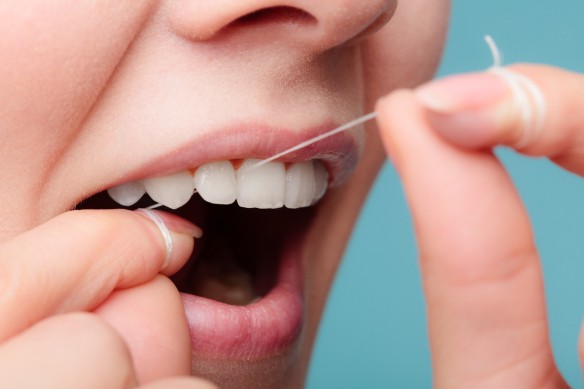
Oral hygiene and health care. Smiling women use dental floss white healthy teeth.
Dentists have always talked a great deal about maintaining good oral hygiene. Unhealthy gums and decaying teeth can be the core of serious troubles. Isn’t the idea of getting a root canal or even losing your teeth an unwelcome and terrible one? And yet, a significant number of people would choose to do an unpleasant chore like cleaning the toilet instead of running a string between their teeth. If you are one of them and are wondering whether flossing can indeed help in removing plaque or not, then, read along.
A recent series of studies conducted by the Associated Press concluded that flossing your teeth has no convincing advantages. Following this, the U.S. Department of Health and Human Services (HHS) and the Department of Agricultural (USDA) have withdrawn flossing from the guidelines for good oral hygiene.
The lack of sufficient evidence does not necessarily mean the process of flossing is ineffective altogether, says Dr. Edmond Hewlett, a spokesperson for the American Dental Association (ADA). So, in spite of the anti-floss reports, ADA still recommends flossing for gum benefits and all-round oral hygiene.
Dr. Tim Priett, the inventor of Flossolution (an advanced flossing system that uses sonic energy) states that a toothbrush can suitably clean three out of the five surfaces on each of our teeth namely the front, back, and top, or bottom of the tooth. The rest two, which include the sides of the tooth adjacent to the other teeth, require flossing to dislodge the leftover food crumbs and bacterial formation.
Flossing As a Preventive Measure
At the primary level, dentists and periodontists advise their patients to floss once a day for two chief preventive purposes. One, it can prevent cavities by eliminating the acid-producing film of bacteria in the dental plaque. Two, it helps to reduce gingivitis, the first stage of gum disease resulting from inflammation.
However, studies could not explain much about the connection between tooth decay and flossing. The recommendations are, therefore, not research-based. Instead, it is dentists who have reported that flossing regularly can impede the decay in patients with an early-stage cavity.
On the other hand, there is considerable proof of lower levels of gum diseases with flossing. A review of 12 studies showed that individuals who brushed and flossed daily have lesser chances of experiencing bleeding gums than those who left flossing out of their oral hygiene routine.
The periodontal disease or gum disease is an immune system-mediated chronic inflammatory disease. It occurs due to the bacteria biofilm in plaque that forms tartar, a hard mineral deposit. If you go without treatment despite the swelling and gum irritation, it can result in receding gums and tooth loss in the long run.
And no, it doesn’t end there. As Leena Palomo DDS, a professor of periodontics, rightly points out, “The mouth is a mirror for the rest of the human body.” Thus, gum disease is also associated with many health issues such as diabetes, heart disease, premature birth, rheumatoid arthritis, etc. While scientists are yet to discover the exact link between them, in all possibility, the bacteria causing the gum disease passed onto the bloodstream. It then induces inflammation in other body parts like the heart.
Since most toothbrushes cannot reach the interproximal areas, the correct use of dental floss is essential to minimize the chances of tooth decay and gum disease.
Flossing Correctly to Get the Best Results
To maintain good oral hygiene, your aim should be to floss correctly and effectively. Here’s how you should proceed:
Experiencing pain might mean that you are employing your dental floss the wrong way. A wrongful use is almost equivalent to not using it in the first case, if not worse. Consult your dentist and follow the above steps cautiously.
Do not try to evade flossing just because you read in some medical journal that its benefits lack evidence. Taking out plaque is essential if you want to avoid premature tooth loss. And a brush cannot do it all. A little pain is completely worth the long term benefits of great oral hygiene. So, start using a string of dental floss and notice the difference yourself. If you are a dentist or periodontist, urge your patients to use it. Furthermore, keep yourself updated with the latest developments in your field by taking a dental opioid CE course. Through such courses, dentists can learn about the various types of opioid medications and what the correct dosage is for different patients.
In the ever-evolving world of skincare, the demand for effective and natural solutions has skyrocketed,… Read More
Summer is here and is the beach and all the casual outings. The best thing… Read More
Skincare is a very vast industry with new products getting launched almost every month. Everyone… Read More
Hello! Spring season. The Spring season is one of my favourite seasons. The reason is… Read More
Long, thick, fluttery lashes aren’t just reserved for the stars. They are reserved for our… Read More
Valentine's Day around the corner and ladies are excited about the outfit to impress their… Read More
This website uses cookies.